Financial Analysis of General Motors and Ford Motors Report
VerifiedAdded on 2023/05/28
|13
|3894
|175
Report
AI Summary
This report conducts a detailed financial analysis of General Motors and Ford Motors, focusing on profitability, liquidity, asset management, debt management, and market returns over three years. It employs ratio analysis to compare the companies' financial positions and competitive standing within the automotive sector, relative to industry averages. The report also evaluates their corporate governance structures and corporate social responsibility initiatives, highlighting similarities and differences. Key financial data, including gross profit, net profit, sales, assets, and liabilities, are examined to provide insights for investors. The analysis reveals trends in profitability, liquidity, and efficiency, offering a comprehensive view of the companies' performance and strategic approaches.
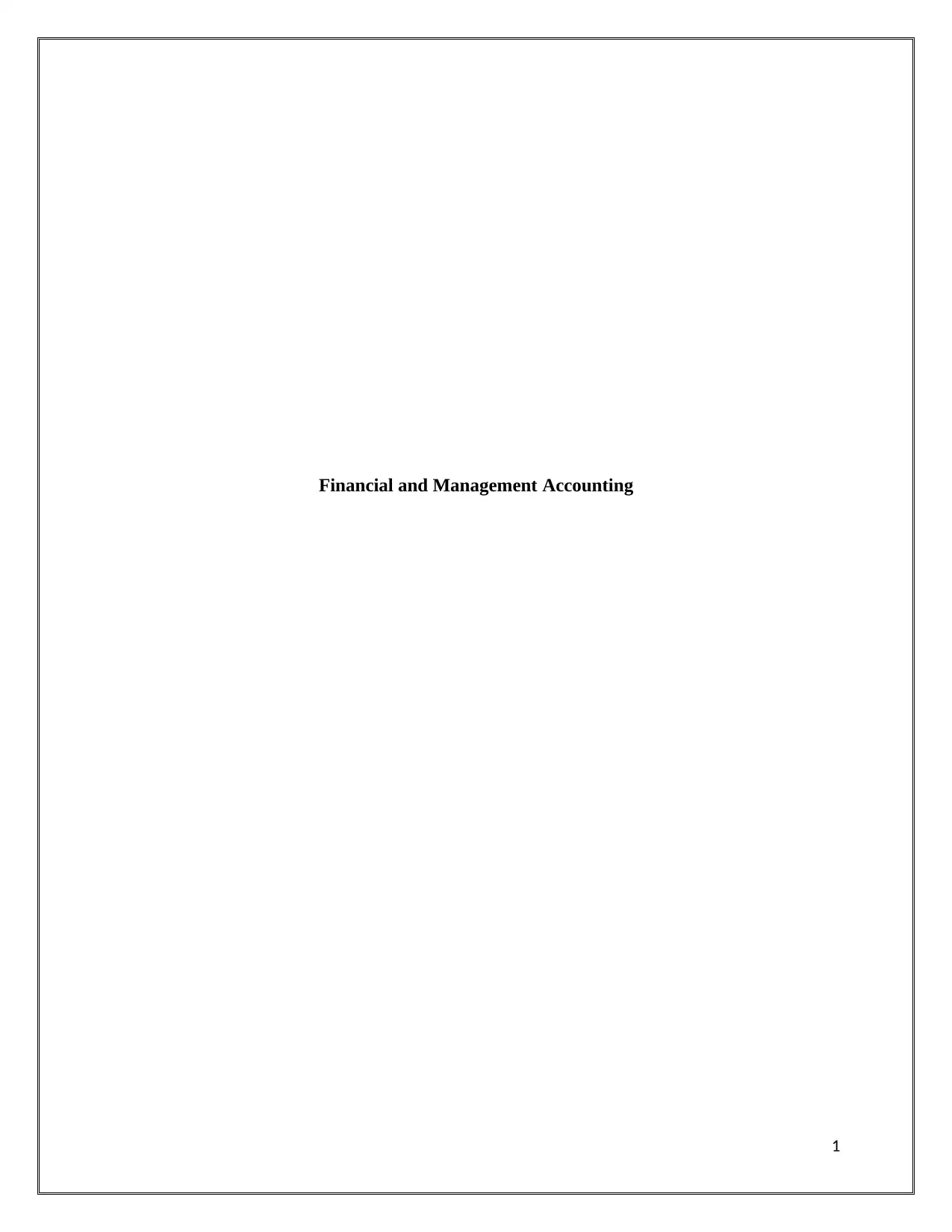
Financial and Management Accounting
1
1
Paraphrase This Document
Need a fresh take? Get an instant paraphrase of this document with our AI Paraphraser
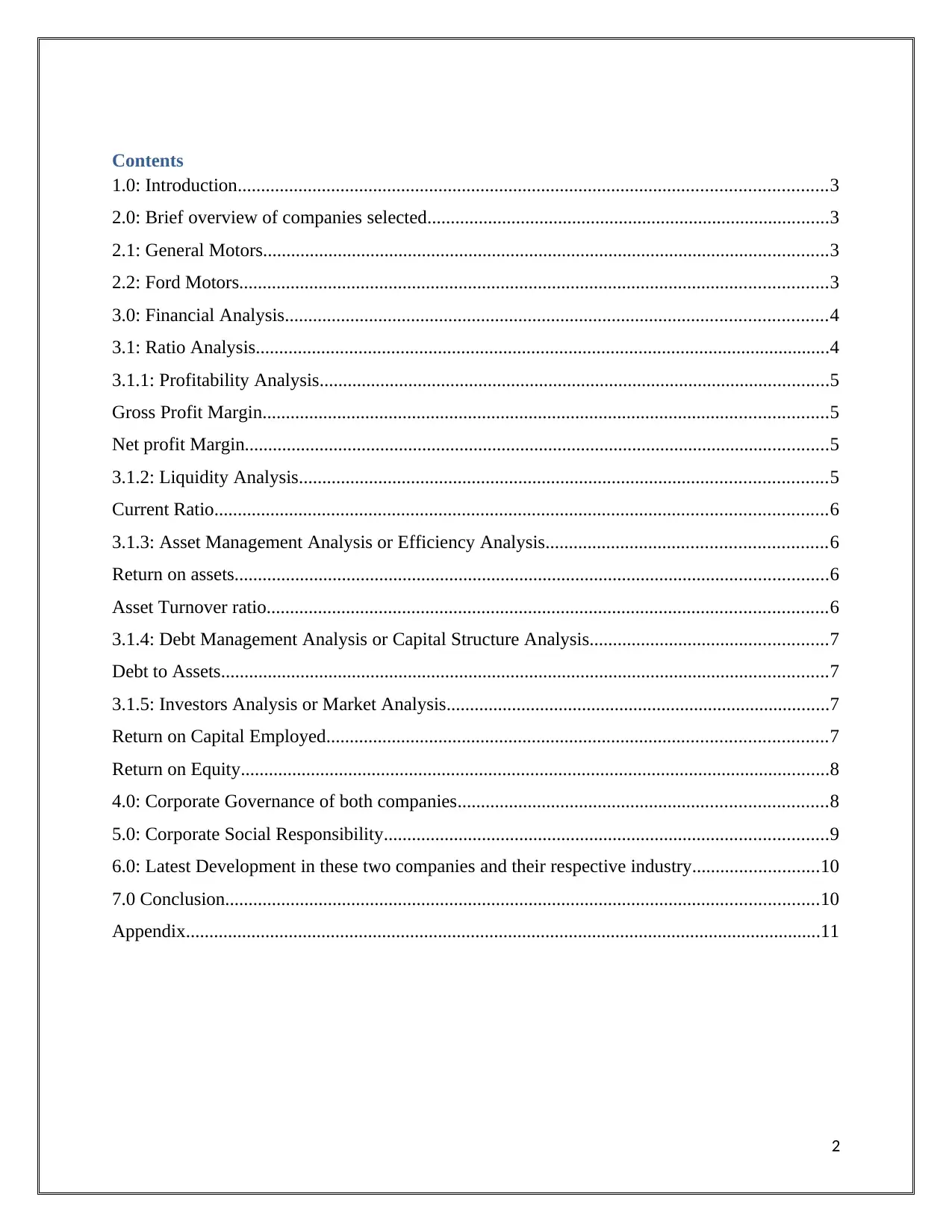
Contents
1.0: Introduction..............................................................................................................................3
2.0: Brief overview of companies selected......................................................................................3
2.1: General Motors.........................................................................................................................3
2.2: Ford Motors..............................................................................................................................3
3.0: Financial Analysis....................................................................................................................4
3.1: Ratio Analysis...........................................................................................................................4
3.1.1: Profitability Analysis.............................................................................................................5
Gross Profit Margin.........................................................................................................................5
Net profit Margin.............................................................................................................................5
3.1.2: Liquidity Analysis.................................................................................................................5
Current Ratio...................................................................................................................................6
3.1.3: Asset Management Analysis or Efficiency Analysis............................................................6
Return on assets...............................................................................................................................6
Asset Turnover ratio........................................................................................................................6
3.1.4: Debt Management Analysis or Capital Structure Analysis...................................................7
Debt to Assets..................................................................................................................................7
3.1.5: Investors Analysis or Market Analysis..................................................................................7
Return on Capital Employed...........................................................................................................7
Return on Equity..............................................................................................................................8
4.0: Corporate Governance of both companies...............................................................................8
5.0: Corporate Social Responsibility...............................................................................................9
6.0: Latest Development in these two companies and their respective industry...........................10
7.0 Conclusion...............................................................................................................................10
Appendix........................................................................................................................................11
2
1.0: Introduction..............................................................................................................................3
2.0: Brief overview of companies selected......................................................................................3
2.1: General Motors.........................................................................................................................3
2.2: Ford Motors..............................................................................................................................3
3.0: Financial Analysis....................................................................................................................4
3.1: Ratio Analysis...........................................................................................................................4
3.1.1: Profitability Analysis.............................................................................................................5
Gross Profit Margin.........................................................................................................................5
Net profit Margin.............................................................................................................................5
3.1.2: Liquidity Analysis.................................................................................................................5
Current Ratio...................................................................................................................................6
3.1.3: Asset Management Analysis or Efficiency Analysis............................................................6
Return on assets...............................................................................................................................6
Asset Turnover ratio........................................................................................................................6
3.1.4: Debt Management Analysis or Capital Structure Analysis...................................................7
Debt to Assets..................................................................................................................................7
3.1.5: Investors Analysis or Market Analysis..................................................................................7
Return on Capital Employed...........................................................................................................7
Return on Equity..............................................................................................................................8
4.0: Corporate Governance of both companies...............................................................................8
5.0: Corporate Social Responsibility...............................................................................................9
6.0: Latest Development in these two companies and their respective industry...........................10
7.0 Conclusion...............................................................................................................................10
Appendix........................................................................................................................................11
2
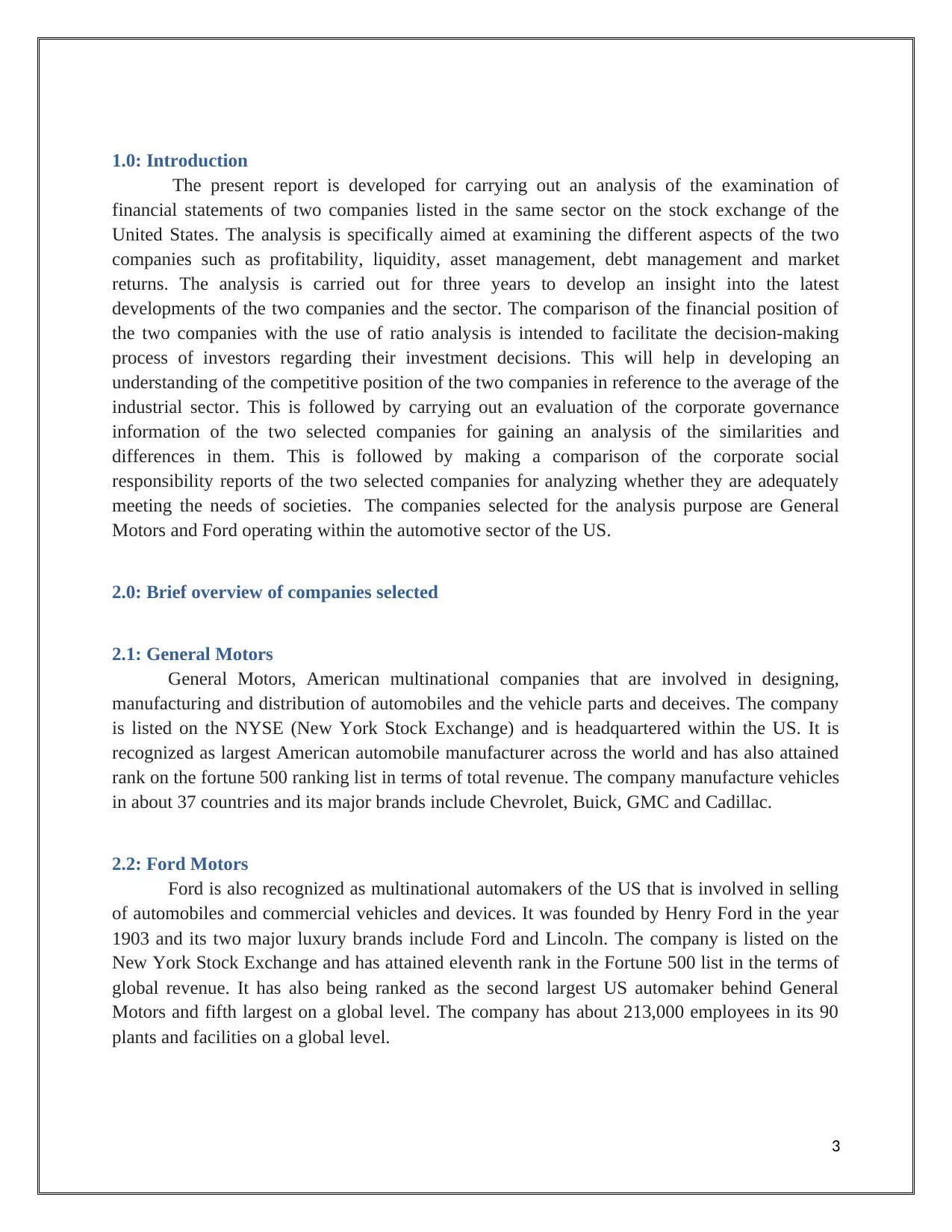
1.0: Introduction
The present report is developed for carrying out an analysis of the examination of
financial statements of two companies listed in the same sector on the stock exchange of the
United States. The analysis is specifically aimed at examining the different aspects of the two
companies such as profitability, liquidity, asset management, debt management and market
returns. The analysis is carried out for three years to develop an insight into the latest
developments of the two companies and the sector. The comparison of the financial position of
the two companies with the use of ratio analysis is intended to facilitate the decision-making
process of investors regarding their investment decisions. This will help in developing an
understanding of the competitive position of the two companies in reference to the average of the
industrial sector. This is followed by carrying out an evaluation of the corporate governance
information of the two selected companies for gaining an analysis of the similarities and
differences in them. This is followed by making a comparison of the corporate social
responsibility reports of the two selected companies for analyzing whether they are adequately
meeting the needs of societies. The companies selected for the analysis purpose are General
Motors and Ford operating within the automotive sector of the US.
2.0: Brief overview of companies selected
2.1: General Motors
General Motors, American multinational companies that are involved in designing,
manufacturing and distribution of automobiles and the vehicle parts and deceives. The company
is listed on the NYSE (New York Stock Exchange) and is headquartered within the US. It is
recognized as largest American automobile manufacturer across the world and has also attained
rank on the fortune 500 ranking list in terms of total revenue. The company manufacture vehicles
in about 37 countries and its major brands include Chevrolet, Buick, GMC and Cadillac.
2.2: Ford Motors
Ford is also recognized as multinational automakers of the US that is involved in selling
of automobiles and commercial vehicles and devices. It was founded by Henry Ford in the year
1903 and its two major luxury brands include Ford and Lincoln. The company is listed on the
New York Stock Exchange and has attained eleventh rank in the Fortune 500 list in the terms of
global revenue. It has also being ranked as the second largest US automaker behind General
Motors and fifth largest on a global level. The company has about 213,000 employees in its 90
plants and facilities on a global level.
3
The present report is developed for carrying out an analysis of the examination of
financial statements of two companies listed in the same sector on the stock exchange of the
United States. The analysis is specifically aimed at examining the different aspects of the two
companies such as profitability, liquidity, asset management, debt management and market
returns. The analysis is carried out for three years to develop an insight into the latest
developments of the two companies and the sector. The comparison of the financial position of
the two companies with the use of ratio analysis is intended to facilitate the decision-making
process of investors regarding their investment decisions. This will help in developing an
understanding of the competitive position of the two companies in reference to the average of the
industrial sector. This is followed by carrying out an evaluation of the corporate governance
information of the two selected companies for gaining an analysis of the similarities and
differences in them. This is followed by making a comparison of the corporate social
responsibility reports of the two selected companies for analyzing whether they are adequately
meeting the needs of societies. The companies selected for the analysis purpose are General
Motors and Ford operating within the automotive sector of the US.
2.0: Brief overview of companies selected
2.1: General Motors
General Motors, American multinational companies that are involved in designing,
manufacturing and distribution of automobiles and the vehicle parts and deceives. The company
is listed on the NYSE (New York Stock Exchange) and is headquartered within the US. It is
recognized as largest American automobile manufacturer across the world and has also attained
rank on the fortune 500 ranking list in terms of total revenue. The company manufacture vehicles
in about 37 countries and its major brands include Chevrolet, Buick, GMC and Cadillac.
2.2: Ford Motors
Ford is also recognized as multinational automakers of the US that is involved in selling
of automobiles and commercial vehicles and devices. It was founded by Henry Ford in the year
1903 and its two major luxury brands include Ford and Lincoln. The company is listed on the
New York Stock Exchange and has attained eleventh rank in the Fortune 500 list in the terms of
global revenue. It has also being ranked as the second largest US automaker behind General
Motors and fifth largest on a global level. The company has about 213,000 employees in its 90
plants and facilities on a global level.
3
⊘ This is a preview!⊘
Do you want full access?
Subscribe today to unlock all pages.

Trusted by 1+ million students worldwide
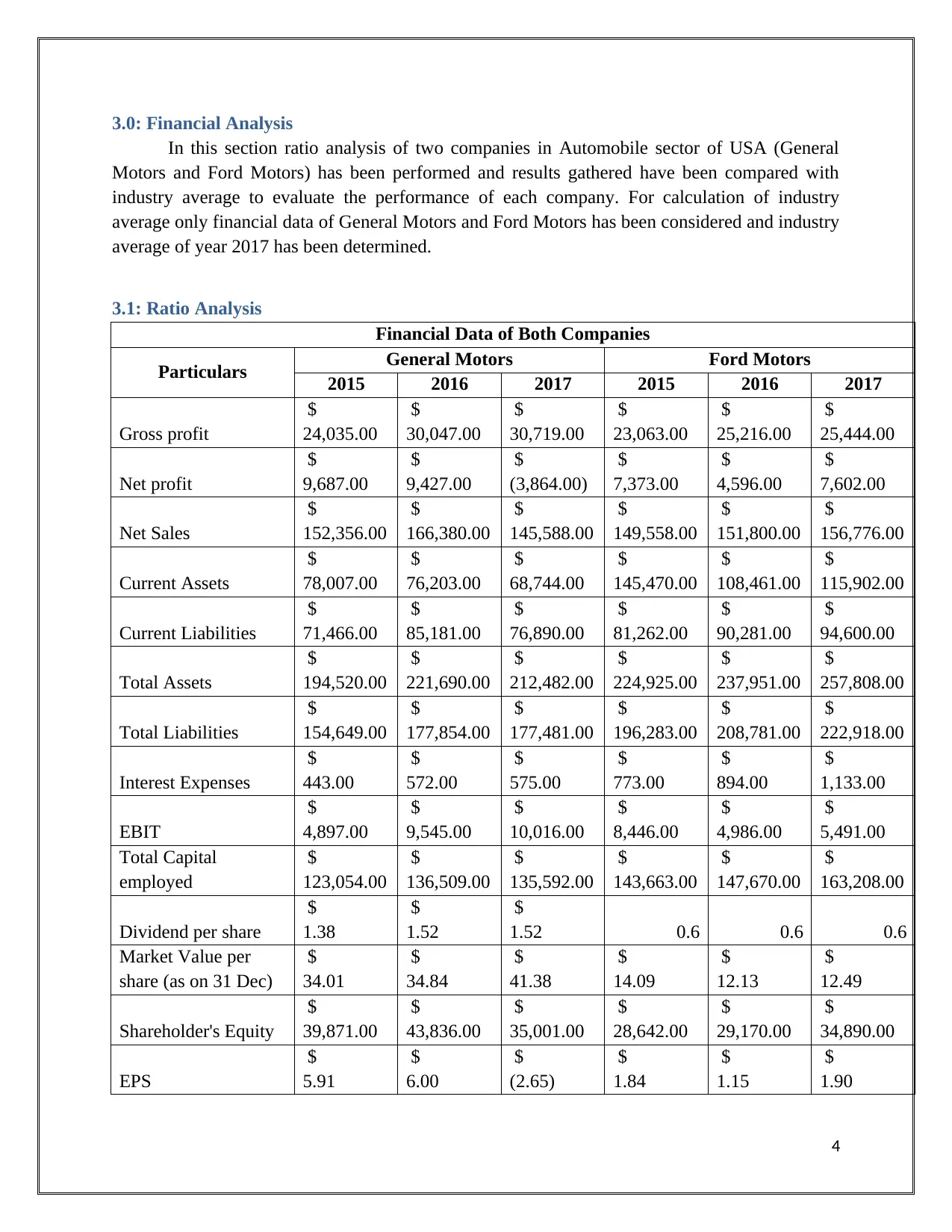
3.0: Financial Analysis
In this section ratio analysis of two companies in Automobile sector of USA (General
Motors and Ford Motors) has been performed and results gathered have been compared with
industry average to evaluate the performance of each company. For calculation of industry
average only financial data of General Motors and Ford Motors has been considered and industry
average of year 2017 has been determined.
3.1: Ratio Analysis
Financial Data of Both Companies
Particulars General Motors Ford Motors
2015 2016 2017 2015 2016 2017
Gross profit
$
24,035.00
$
30,047.00
$
30,719.00
$
23,063.00
$
25,216.00
$
25,444.00
Net profit
$
9,687.00
$
9,427.00
$
(3,864.00)
$
7,373.00
$
4,596.00
$
7,602.00
Net Sales
$
152,356.00
$
166,380.00
$
145,588.00
$
149,558.00
$
151,800.00
$
156,776.00
Current Assets
$
78,007.00
$
76,203.00
$
68,744.00
$
145,470.00
$
108,461.00
$
115,902.00
Current Liabilities
$
71,466.00
$
85,181.00
$
76,890.00
$
81,262.00
$
90,281.00
$
94,600.00
Total Assets
$
194,520.00
$
221,690.00
$
212,482.00
$
224,925.00
$
237,951.00
$
257,808.00
Total Liabilities
$
154,649.00
$
177,854.00
$
177,481.00
$
196,283.00
$
208,781.00
$
222,918.00
Interest Expenses
$
443.00
$
572.00
$
575.00
$
773.00
$
894.00
$
1,133.00
EBIT
$
4,897.00
$
9,545.00
$
10,016.00
$
8,446.00
$
4,986.00
$
5,491.00
Total Capital
employed
$
123,054.00
$
136,509.00
$
135,592.00
$
143,663.00
$
147,670.00
$
163,208.00
Dividend per share
$
1.38
$
1.52
$
1.52 0.6 0.6 0.6
Market Value per
share (as on 31 Dec)
$
34.01
$
34.84
$
41.38
$
14.09
$
12.13
$
12.49
Shareholder's Equity
$
39,871.00
$
43,836.00
$
35,001.00
$
28,642.00
$
29,170.00
$
34,890.00
EPS
$
5.91
$
6.00
$
(2.65)
$
1.84
$
1.15
$
1.90
4
In this section ratio analysis of two companies in Automobile sector of USA (General
Motors and Ford Motors) has been performed and results gathered have been compared with
industry average to evaluate the performance of each company. For calculation of industry
average only financial data of General Motors and Ford Motors has been considered and industry
average of year 2017 has been determined.
3.1: Ratio Analysis
Financial Data of Both Companies
Particulars General Motors Ford Motors
2015 2016 2017 2015 2016 2017
Gross profit
$
24,035.00
$
30,047.00
$
30,719.00
$
23,063.00
$
25,216.00
$
25,444.00
Net profit
$
9,687.00
$
9,427.00
$
(3,864.00)
$
7,373.00
$
4,596.00
$
7,602.00
Net Sales
$
152,356.00
$
166,380.00
$
145,588.00
$
149,558.00
$
151,800.00
$
156,776.00
Current Assets
$
78,007.00
$
76,203.00
$
68,744.00
$
145,470.00
$
108,461.00
$
115,902.00
Current Liabilities
$
71,466.00
$
85,181.00
$
76,890.00
$
81,262.00
$
90,281.00
$
94,600.00
Total Assets
$
194,520.00
$
221,690.00
$
212,482.00
$
224,925.00
$
237,951.00
$
257,808.00
Total Liabilities
$
154,649.00
$
177,854.00
$
177,481.00
$
196,283.00
$
208,781.00
$
222,918.00
Interest Expenses
$
443.00
$
572.00
$
575.00
$
773.00
$
894.00
$
1,133.00
EBIT
$
4,897.00
$
9,545.00
$
10,016.00
$
8,446.00
$
4,986.00
$
5,491.00
Total Capital
employed
$
123,054.00
$
136,509.00
$
135,592.00
$
143,663.00
$
147,670.00
$
163,208.00
Dividend per share
$
1.38
$
1.52
$
1.52 0.6 0.6 0.6
Market Value per
share (as on 31 Dec)
$
34.01
$
34.84
$
41.38
$
14.09
$
12.13
$
12.49
Shareholder's Equity
$
39,871.00
$
43,836.00
$
35,001.00
$
28,642.00
$
29,170.00
$
34,890.00
EPS
$
5.91
$
6.00
$
(2.65)
$
1.84
$
1.15
$
1.90
4
Paraphrase This Document
Need a fresh take? Get an instant paraphrase of this document with our AI Paraphraser
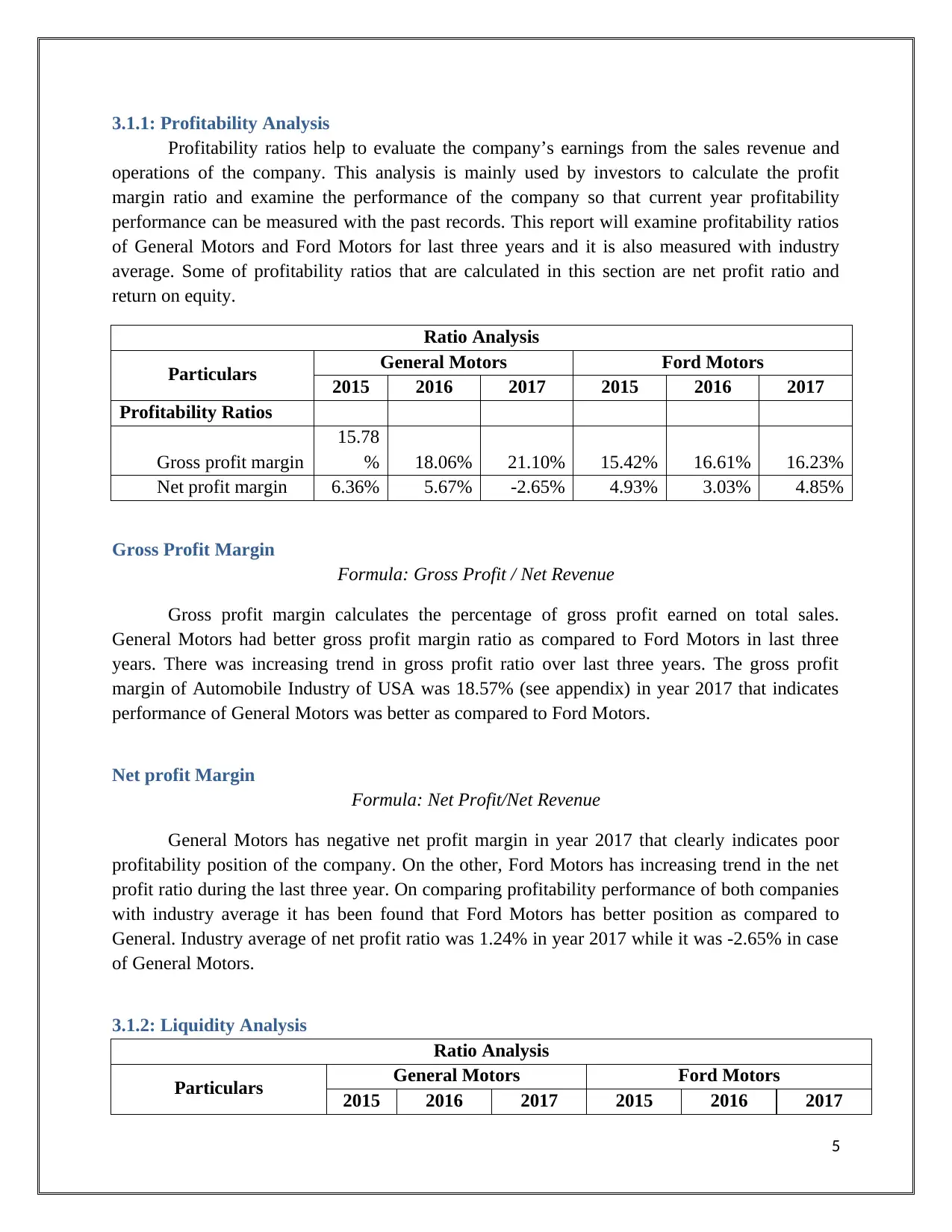
3.1.1: Profitability Analysis
Profitability ratios help to evaluate the company’s earnings from the sales revenue and
operations of the company. This analysis is mainly used by investors to calculate the profit
margin ratio and examine the performance of the company so that current year profitability
performance can be measured with the past records. This report will examine profitability ratios
of General Motors and Ford Motors for last three years and it is also measured with industry
average. Some of profitability ratios that are calculated in this section are net profit ratio and
return on equity.
Ratio Analysis
Particulars General Motors Ford Motors
2015 2016 2017 2015 2016 2017
Profitability Ratios
Gross profit margin
15.78
% 18.06% 21.10% 15.42% 16.61% 16.23%
Net profit margin 6.36% 5.67% -2.65% 4.93% 3.03% 4.85%
Gross Profit Margin
Formula: Gross Profit / Net Revenue
Gross profit margin calculates the percentage of gross profit earned on total sales.
General Motors had better gross profit margin ratio as compared to Ford Motors in last three
years. There was increasing trend in gross profit ratio over last three years. The gross profit
margin of Automobile Industry of USA was 18.57% (see appendix) in year 2017 that indicates
performance of General Motors was better as compared to Ford Motors.
Net profit Margin
Formula: Net Profit/Net Revenue
General Motors has negative net profit margin in year 2017 that clearly indicates poor
profitability position of the company. On the other, Ford Motors has increasing trend in the net
profit ratio during the last three year. On comparing profitability performance of both companies
with industry average it has been found that Ford Motors has better position as compared to
General. Industry average of net profit ratio was 1.24% in year 2017 while it was -2.65% in case
of General Motors.
3.1.2: Liquidity Analysis
Ratio Analysis
Particulars General Motors Ford Motors
2015 2016 2017 2015 2016 2017
5
Profitability ratios help to evaluate the company’s earnings from the sales revenue and
operations of the company. This analysis is mainly used by investors to calculate the profit
margin ratio and examine the performance of the company so that current year profitability
performance can be measured with the past records. This report will examine profitability ratios
of General Motors and Ford Motors for last three years and it is also measured with industry
average. Some of profitability ratios that are calculated in this section are net profit ratio and
return on equity.
Ratio Analysis
Particulars General Motors Ford Motors
2015 2016 2017 2015 2016 2017
Profitability Ratios
Gross profit margin
15.78
% 18.06% 21.10% 15.42% 16.61% 16.23%
Net profit margin 6.36% 5.67% -2.65% 4.93% 3.03% 4.85%
Gross Profit Margin
Formula: Gross Profit / Net Revenue
Gross profit margin calculates the percentage of gross profit earned on total sales.
General Motors had better gross profit margin ratio as compared to Ford Motors in last three
years. There was increasing trend in gross profit ratio over last three years. The gross profit
margin of Automobile Industry of USA was 18.57% (see appendix) in year 2017 that indicates
performance of General Motors was better as compared to Ford Motors.
Net profit Margin
Formula: Net Profit/Net Revenue
General Motors has negative net profit margin in year 2017 that clearly indicates poor
profitability position of the company. On the other, Ford Motors has increasing trend in the net
profit ratio during the last three year. On comparing profitability performance of both companies
with industry average it has been found that Ford Motors has better position as compared to
General. Industry average of net profit ratio was 1.24% in year 2017 while it was -2.65% in case
of General Motors.
3.1.2: Liquidity Analysis
Ratio Analysis
Particulars General Motors Ford Motors
2015 2016 2017 2015 2016 2017
5
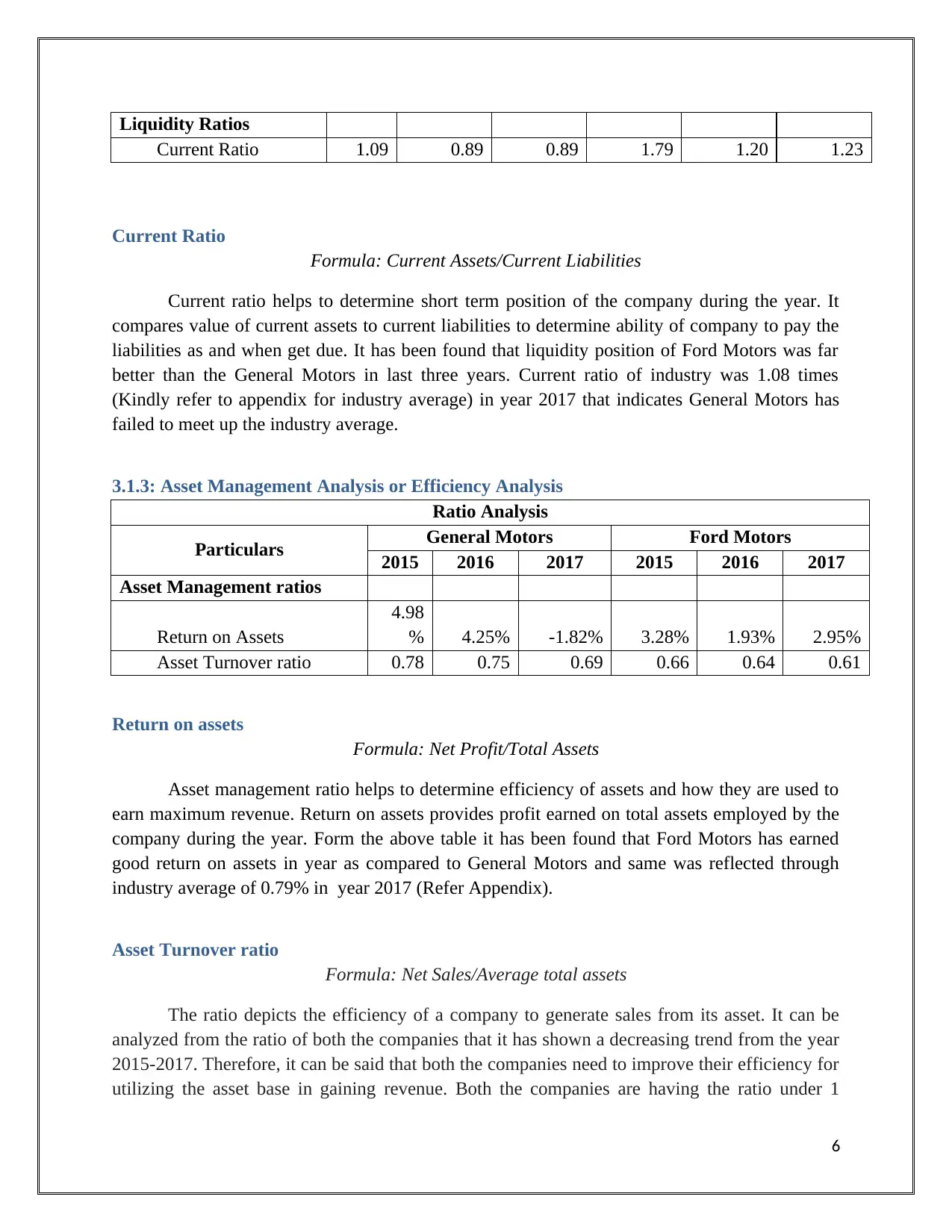
Liquidity Ratios
Current Ratio 1.09 0.89 0.89 1.79 1.20 1.23
Current Ratio
Formula: Current Assets/Current Liabilities
Current ratio helps to determine short term position of the company during the year. It
compares value of current assets to current liabilities to determine ability of company to pay the
liabilities as and when get due. It has been found that liquidity position of Ford Motors was far
better than the General Motors in last three years. Current ratio of industry was 1.08 times
(Kindly refer to appendix for industry average) in year 2017 that indicates General Motors has
failed to meet up the industry average.
3.1.3: Asset Management Analysis or Efficiency Analysis
Ratio Analysis
Particulars General Motors Ford Motors
2015 2016 2017 2015 2016 2017
Asset Management ratios
Return on Assets
4.98
% 4.25% -1.82% 3.28% 1.93% 2.95%
Asset Turnover ratio 0.78 0.75 0.69 0.66 0.64 0.61
Return on assets
Formula: Net Profit/Total Assets
Asset management ratio helps to determine efficiency of assets and how they are used to
earn maximum revenue. Return on assets provides profit earned on total assets employed by the
company during the year. Form the above table it has been found that Ford Motors has earned
good return on assets in year as compared to General Motors and same was reflected through
industry average of 0.79% in year 2017 (Refer Appendix).
Asset Turnover ratio
Formula: Net Sales/Average total assets
The ratio depicts the efficiency of a company to generate sales from its asset. It can be
analyzed from the ratio of both the companies that it has shown a decreasing trend from the year
2015-2017. Therefore, it can be said that both the companies need to improve their efficiency for
utilizing the asset base in gaining revenue. Both the companies are having the ratio under 1
6
Current Ratio 1.09 0.89 0.89 1.79 1.20 1.23
Current Ratio
Formula: Current Assets/Current Liabilities
Current ratio helps to determine short term position of the company during the year. It
compares value of current assets to current liabilities to determine ability of company to pay the
liabilities as and when get due. It has been found that liquidity position of Ford Motors was far
better than the General Motors in last three years. Current ratio of industry was 1.08 times
(Kindly refer to appendix for industry average) in year 2017 that indicates General Motors has
failed to meet up the industry average.
3.1.3: Asset Management Analysis or Efficiency Analysis
Ratio Analysis
Particulars General Motors Ford Motors
2015 2016 2017 2015 2016 2017
Asset Management ratios
Return on Assets
4.98
% 4.25% -1.82% 3.28% 1.93% 2.95%
Asset Turnover ratio 0.78 0.75 0.69 0.66 0.64 0.61
Return on assets
Formula: Net Profit/Total Assets
Asset management ratio helps to determine efficiency of assets and how they are used to
earn maximum revenue. Return on assets provides profit earned on total assets employed by the
company during the year. Form the above table it has been found that Ford Motors has earned
good return on assets in year as compared to General Motors and same was reflected through
industry average of 0.79% in year 2017 (Refer Appendix).
Asset Turnover ratio
Formula: Net Sales/Average total assets
The ratio depicts the efficiency of a company to generate sales from its asset. It can be
analyzed from the ratio of both the companies that it has shown a decreasing trend from the year
2015-2017. Therefore, it can be said that both the companies need to improve their efficiency for
utilizing the asset base in gaining revenue. Both the companies are having the ratio under 1
6
⊘ This is a preview!⊘
Do you want full access?
Subscribe today to unlock all pages.

Trusted by 1+ million students worldwide
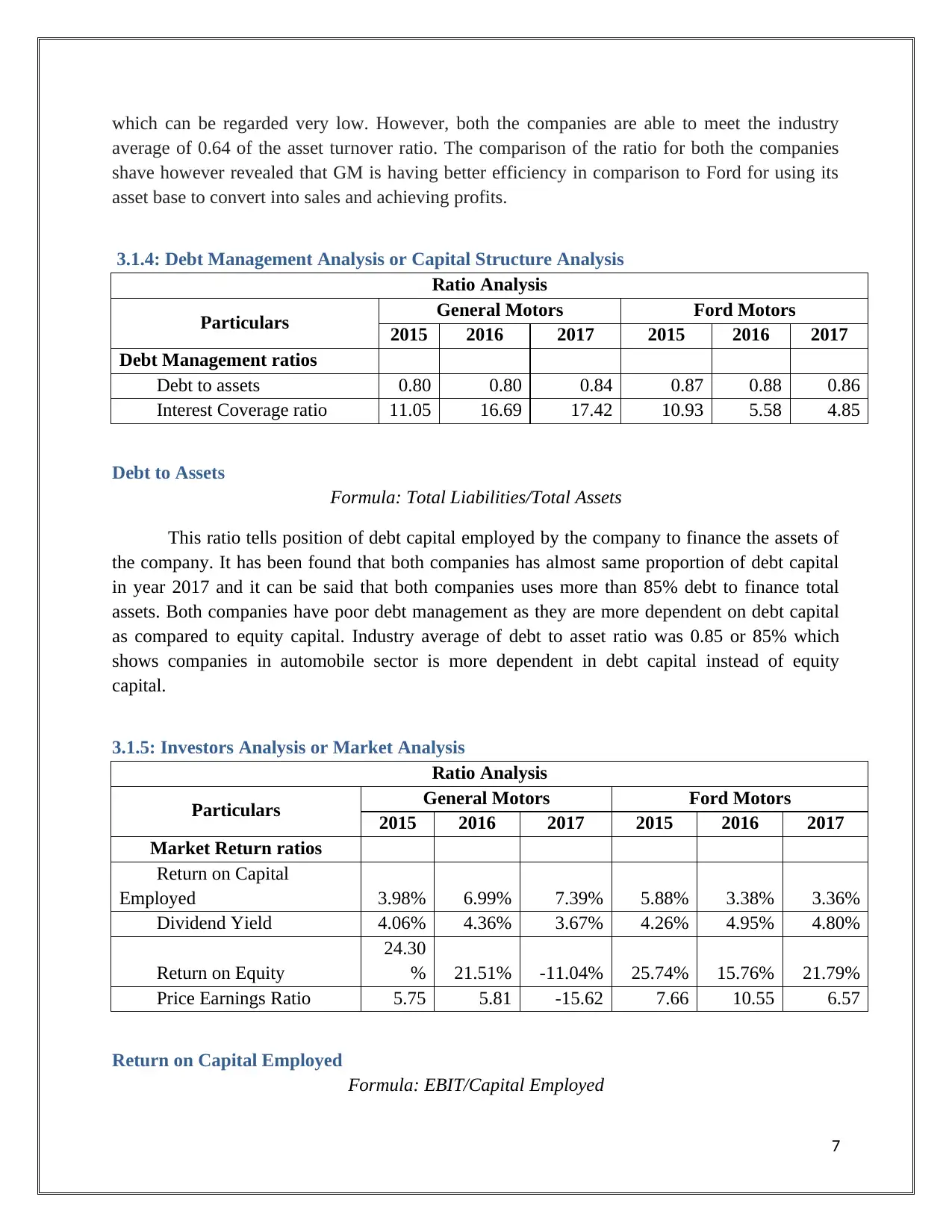
which can be regarded very low. However, both the companies are able to meet the industry
average of 0.64 of the asset turnover ratio. The comparison of the ratio for both the companies
shave however revealed that GM is having better efficiency in comparison to Ford for using its
asset base to convert into sales and achieving profits.
3.1.4: Debt Management Analysis or Capital Structure Analysis
Ratio Analysis
Particulars General Motors Ford Motors
2015 2016 2017 2015 2016 2017
Debt Management ratios
Debt to assets 0.80 0.80 0.84 0.87 0.88 0.86
Interest Coverage ratio 11.05 16.69 17.42 10.93 5.58 4.85
Debt to Assets
Formula: Total Liabilities/Total Assets
This ratio tells position of debt capital employed by the company to finance the assets of
the company. It has been found that both companies has almost same proportion of debt capital
in year 2017 and it can be said that both companies uses more than 85% debt to finance total
assets. Both companies have poor debt management as they are more dependent on debt capital
as compared to equity capital. Industry average of debt to asset ratio was 0.85 or 85% which
shows companies in automobile sector is more dependent in debt capital instead of equity
capital.
3.1.5: Investors Analysis or Market Analysis
Ratio Analysis
Particulars General Motors Ford Motors
2015 2016 2017 2015 2016 2017
Market Return ratios
Return on Capital
Employed 3.98% 6.99% 7.39% 5.88% 3.38% 3.36%
Dividend Yield 4.06% 4.36% 3.67% 4.26% 4.95% 4.80%
Return on Equity
24.30
% 21.51% -11.04% 25.74% 15.76% 21.79%
Price Earnings Ratio 5.75 5.81 -15.62 7.66 10.55 6.57
Return on Capital Employed
Formula: EBIT/Capital Employed
7
average of 0.64 of the asset turnover ratio. The comparison of the ratio for both the companies
shave however revealed that GM is having better efficiency in comparison to Ford for using its
asset base to convert into sales and achieving profits.
3.1.4: Debt Management Analysis or Capital Structure Analysis
Ratio Analysis
Particulars General Motors Ford Motors
2015 2016 2017 2015 2016 2017
Debt Management ratios
Debt to assets 0.80 0.80 0.84 0.87 0.88 0.86
Interest Coverage ratio 11.05 16.69 17.42 10.93 5.58 4.85
Debt to Assets
Formula: Total Liabilities/Total Assets
This ratio tells position of debt capital employed by the company to finance the assets of
the company. It has been found that both companies has almost same proportion of debt capital
in year 2017 and it can be said that both companies uses more than 85% debt to finance total
assets. Both companies have poor debt management as they are more dependent on debt capital
as compared to equity capital. Industry average of debt to asset ratio was 0.85 or 85% which
shows companies in automobile sector is more dependent in debt capital instead of equity
capital.
3.1.5: Investors Analysis or Market Analysis
Ratio Analysis
Particulars General Motors Ford Motors
2015 2016 2017 2015 2016 2017
Market Return ratios
Return on Capital
Employed 3.98% 6.99% 7.39% 5.88% 3.38% 3.36%
Dividend Yield 4.06% 4.36% 3.67% 4.26% 4.95% 4.80%
Return on Equity
24.30
% 21.51% -11.04% 25.74% 15.76% 21.79%
Price Earnings Ratio 5.75 5.81 -15.62 7.66 10.55 6.57
Return on Capital Employed
Formula: EBIT/Capital Employed
7
Paraphrase This Document
Need a fresh take? Get an instant paraphrase of this document with our AI Paraphraser
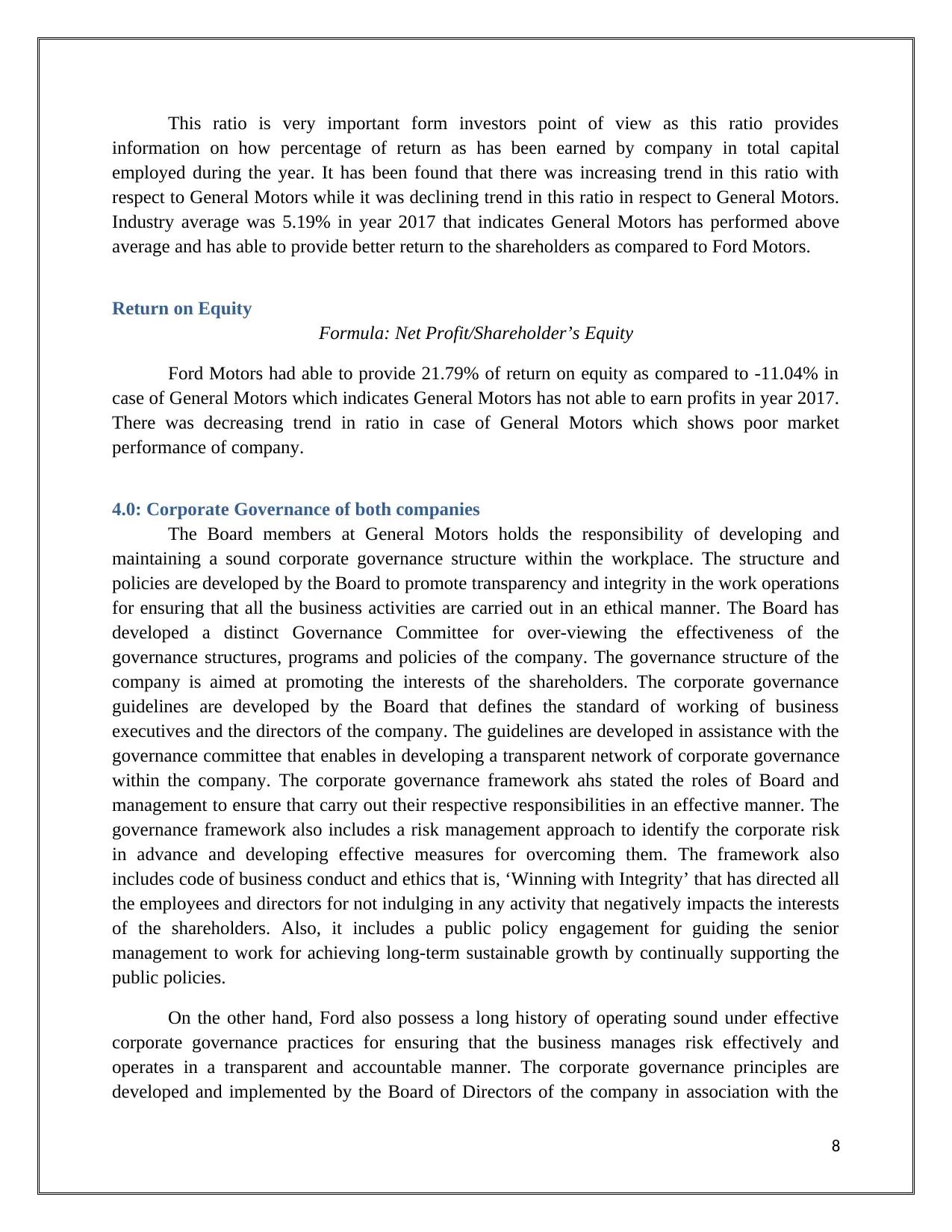
This ratio is very important form investors point of view as this ratio provides
information on how percentage of return as has been earned by company in total capital
employed during the year. It has been found that there was increasing trend in this ratio with
respect to General Motors while it was declining trend in this ratio in respect to General Motors.
Industry average was 5.19% in year 2017 that indicates General Motors has performed above
average and has able to provide better return to the shareholders as compared to Ford Motors.
Return on Equity
Formula: Net Profit/Shareholder’s Equity
Ford Motors had able to provide 21.79% of return on equity as compared to -11.04% in
case of General Motors which indicates General Motors has not able to earn profits in year 2017.
There was decreasing trend in ratio in case of General Motors which shows poor market
performance of company.
4.0: Corporate Governance of both companies
The Board members at General Motors holds the responsibility of developing and
maintaining a sound corporate governance structure within the workplace. The structure and
policies are developed by the Board to promote transparency and integrity in the work operations
for ensuring that all the business activities are carried out in an ethical manner. The Board has
developed a distinct Governance Committee for over-viewing the effectiveness of the
governance structures, programs and policies of the company. The governance structure of the
company is aimed at promoting the interests of the shareholders. The corporate governance
guidelines are developed by the Board that defines the standard of working of business
executives and the directors of the company. The guidelines are developed in assistance with the
governance committee that enables in developing a transparent network of corporate governance
within the company. The corporate governance framework ahs stated the roles of Board and
management to ensure that carry out their respective responsibilities in an effective manner. The
governance framework also includes a risk management approach to identify the corporate risk
in advance and developing effective measures for overcoming them. The framework also
includes code of business conduct and ethics that is, ‘Winning with Integrity’ that has directed all
the employees and directors for not indulging in any activity that negatively impacts the interests
of the shareholders. Also, it includes a public policy engagement for guiding the senior
management to work for achieving long-term sustainable growth by continually supporting the
public policies.
On the other hand, Ford also possess a long history of operating sound under effective
corporate governance practices for ensuring that the business manages risk effectively and
operates in a transparent and accountable manner. The corporate governance principles are
developed and implemented by the Board of Directors of the company in association with the
8
information on how percentage of return as has been earned by company in total capital
employed during the year. It has been found that there was increasing trend in this ratio with
respect to General Motors while it was declining trend in this ratio in respect to General Motors.
Industry average was 5.19% in year 2017 that indicates General Motors has performed above
average and has able to provide better return to the shareholders as compared to Ford Motors.
Return on Equity
Formula: Net Profit/Shareholder’s Equity
Ford Motors had able to provide 21.79% of return on equity as compared to -11.04% in
case of General Motors which indicates General Motors has not able to earn profits in year 2017.
There was decreasing trend in ratio in case of General Motors which shows poor market
performance of company.
4.0: Corporate Governance of both companies
The Board members at General Motors holds the responsibility of developing and
maintaining a sound corporate governance structure within the workplace. The structure and
policies are developed by the Board to promote transparency and integrity in the work operations
for ensuring that all the business activities are carried out in an ethical manner. The Board has
developed a distinct Governance Committee for over-viewing the effectiveness of the
governance structures, programs and policies of the company. The governance structure of the
company is aimed at promoting the interests of the shareholders. The corporate governance
guidelines are developed by the Board that defines the standard of working of business
executives and the directors of the company. The guidelines are developed in assistance with the
governance committee that enables in developing a transparent network of corporate governance
within the company. The corporate governance framework ahs stated the roles of Board and
management to ensure that carry out their respective responsibilities in an effective manner. The
governance framework also includes a risk management approach to identify the corporate risk
in advance and developing effective measures for overcoming them. The framework also
includes code of business conduct and ethics that is, ‘Winning with Integrity’ that has directed all
the employees and directors for not indulging in any activity that negatively impacts the interests
of the shareholders. Also, it includes a public policy engagement for guiding the senior
management to work for achieving long-term sustainable growth by continually supporting the
public policies.
On the other hand, Ford also possess a long history of operating sound under effective
corporate governance practices for ensuring that the business manages risk effectively and
operates in a transparent and accountable manner. The corporate governance principles are
developed and implemented by the Board of Directors of the company in association with the
8
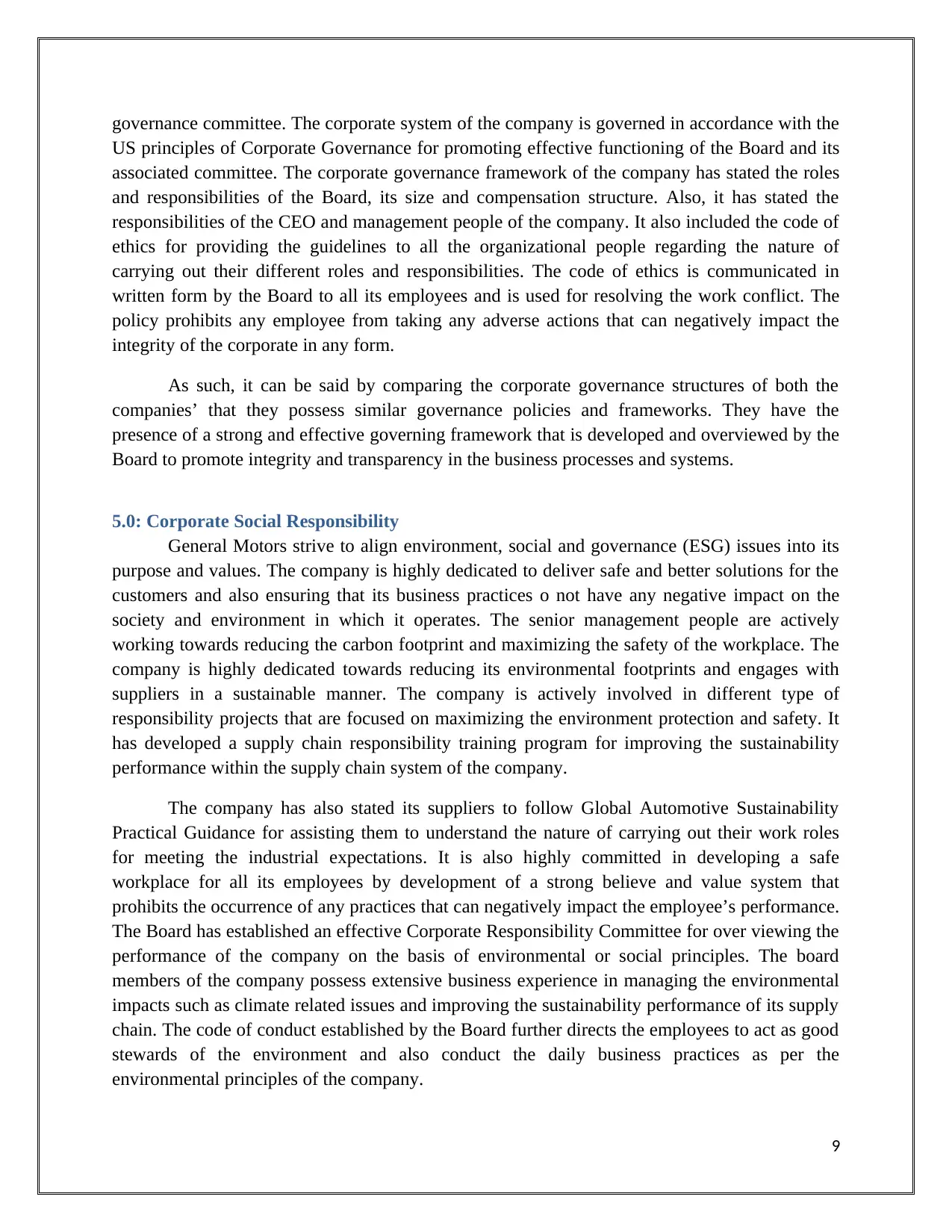
governance committee. The corporate system of the company is governed in accordance with the
US principles of Corporate Governance for promoting effective functioning of the Board and its
associated committee. The corporate governance framework of the company has stated the roles
and responsibilities of the Board, its size and compensation structure. Also, it has stated the
responsibilities of the CEO and management people of the company. It also included the code of
ethics for providing the guidelines to all the organizational people regarding the nature of
carrying out their different roles and responsibilities. The code of ethics is communicated in
written form by the Board to all its employees and is used for resolving the work conflict. The
policy prohibits any employee from taking any adverse actions that can negatively impact the
integrity of the corporate in any form.
As such, it can be said by comparing the corporate governance structures of both the
companies’ that they possess similar governance policies and frameworks. They have the
presence of a strong and effective governing framework that is developed and overviewed by the
Board to promote integrity and transparency in the business processes and systems.
5.0: Corporate Social Responsibility
General Motors strive to align environment, social and governance (ESG) issues into its
purpose and values. The company is highly dedicated to deliver safe and better solutions for the
customers and also ensuring that its business practices o not have any negative impact on the
society and environment in which it operates. The senior management people are actively
working towards reducing the carbon footprint and maximizing the safety of the workplace. The
company is highly dedicated towards reducing its environmental footprints and engages with
suppliers in a sustainable manner. The company is actively involved in different type of
responsibility projects that are focused on maximizing the environment protection and safety. It
has developed a supply chain responsibility training program for improving the sustainability
performance within the supply chain system of the company.
The company has also stated its suppliers to follow Global Automotive Sustainability
Practical Guidance for assisting them to understand the nature of carrying out their work roles
for meeting the industrial expectations. It is also highly committed in developing a safe
workplace for all its employees by development of a strong believe and value system that
prohibits the occurrence of any practices that can negatively impact the employee’s performance.
The Board has established an effective Corporate Responsibility Committee for over viewing the
performance of the company on the basis of environmental or social principles. The board
members of the company possess extensive business experience in managing the environmental
impacts such as climate related issues and improving the sustainability performance of its supply
chain. The code of conduct established by the Board further directs the employees to act as good
stewards of the environment and also conduct the daily business practices as per the
environmental principles of the company.
9
US principles of Corporate Governance for promoting effective functioning of the Board and its
associated committee. The corporate governance framework of the company has stated the roles
and responsibilities of the Board, its size and compensation structure. Also, it has stated the
responsibilities of the CEO and management people of the company. It also included the code of
ethics for providing the guidelines to all the organizational people regarding the nature of
carrying out their different roles and responsibilities. The code of ethics is communicated in
written form by the Board to all its employees and is used for resolving the work conflict. The
policy prohibits any employee from taking any adverse actions that can negatively impact the
integrity of the corporate in any form.
As such, it can be said by comparing the corporate governance structures of both the
companies’ that they possess similar governance policies and frameworks. They have the
presence of a strong and effective governing framework that is developed and overviewed by the
Board to promote integrity and transparency in the business processes and systems.
5.0: Corporate Social Responsibility
General Motors strive to align environment, social and governance (ESG) issues into its
purpose and values. The company is highly dedicated to deliver safe and better solutions for the
customers and also ensuring that its business practices o not have any negative impact on the
society and environment in which it operates. The senior management people are actively
working towards reducing the carbon footprint and maximizing the safety of the workplace. The
company is highly dedicated towards reducing its environmental footprints and engages with
suppliers in a sustainable manner. The company is actively involved in different type of
responsibility projects that are focused on maximizing the environment protection and safety. It
has developed a supply chain responsibility training program for improving the sustainability
performance within the supply chain system of the company.
The company has also stated its suppliers to follow Global Automotive Sustainability
Practical Guidance for assisting them to understand the nature of carrying out their work roles
for meeting the industrial expectations. It is also highly committed in developing a safe
workplace for all its employees by development of a strong believe and value system that
prohibits the occurrence of any practices that can negatively impact the employee’s performance.
The Board has established an effective Corporate Responsibility Committee for over viewing the
performance of the company on the basis of environmental or social principles. The board
members of the company possess extensive business experience in managing the environmental
impacts such as climate related issues and improving the sustainability performance of its supply
chain. The code of conduct established by the Board further directs the employees to act as good
stewards of the environment and also conduct the daily business practices as per the
environmental principles of the company.
9
⊘ This is a preview!⊘
Do you want full access?
Subscribe today to unlock all pages.

Trusted by 1+ million students worldwide
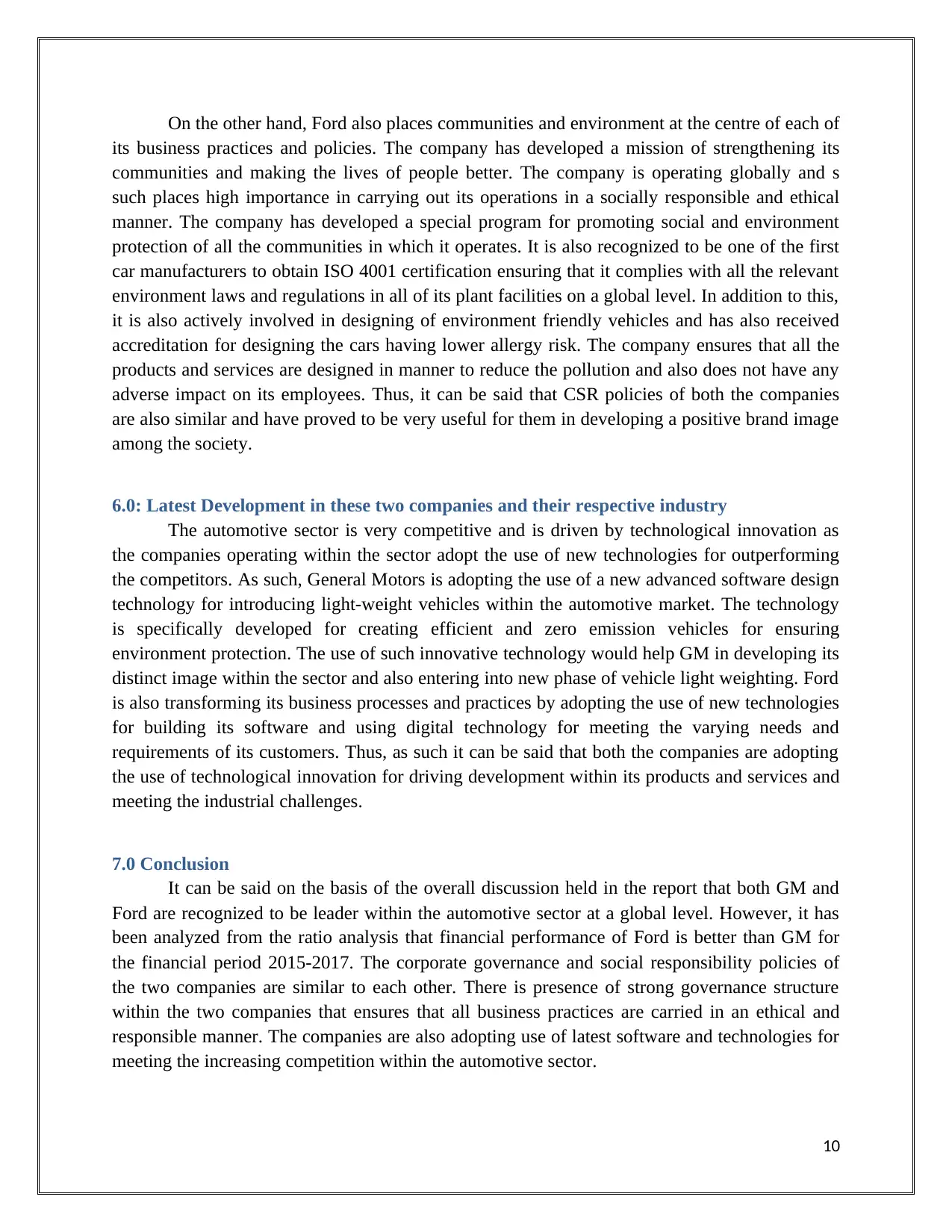
On the other hand, Ford also places communities and environment at the centre of each of
its business practices and policies. The company has developed a mission of strengthening its
communities and making the lives of people better. The company is operating globally and s
such places high importance in carrying out its operations in a socially responsible and ethical
manner. The company has developed a special program for promoting social and environment
protection of all the communities in which it operates. It is also recognized to be one of the first
car manufacturers to obtain ISO 4001 certification ensuring that it complies with all the relevant
environment laws and regulations in all of its plant facilities on a global level. In addition to this,
it is also actively involved in designing of environment friendly vehicles and has also received
accreditation for designing the cars having lower allergy risk. The company ensures that all the
products and services are designed in manner to reduce the pollution and also does not have any
adverse impact on its employees. Thus, it can be said that CSR policies of both the companies
are also similar and have proved to be very useful for them in developing a positive brand image
among the society.
6.0: Latest Development in these two companies and their respective industry
The automotive sector is very competitive and is driven by technological innovation as
the companies operating within the sector adopt the use of new technologies for outperforming
the competitors. As such, General Motors is adopting the use of a new advanced software design
technology for introducing light-weight vehicles within the automotive market. The technology
is specifically developed for creating efficient and zero emission vehicles for ensuring
environment protection. The use of such innovative technology would help GM in developing its
distinct image within the sector and also entering into new phase of vehicle light weighting. Ford
is also transforming its business processes and practices by adopting the use of new technologies
for building its software and using digital technology for meeting the varying needs and
requirements of its customers. Thus, as such it can be said that both the companies are adopting
the use of technological innovation for driving development within its products and services and
meeting the industrial challenges.
7.0 Conclusion
It can be said on the basis of the overall discussion held in the report that both GM and
Ford are recognized to be leader within the automotive sector at a global level. However, it has
been analyzed from the ratio analysis that financial performance of Ford is better than GM for
the financial period 2015-2017. The corporate governance and social responsibility policies of
the two companies are similar to each other. There is presence of strong governance structure
within the two companies that ensures that all business practices are carried in an ethical and
responsible manner. The companies are also adopting use of latest software and technologies for
meeting the increasing competition within the automotive sector.
10
its business practices and policies. The company has developed a mission of strengthening its
communities and making the lives of people better. The company is operating globally and s
such places high importance in carrying out its operations in a socially responsible and ethical
manner. The company has developed a special program for promoting social and environment
protection of all the communities in which it operates. It is also recognized to be one of the first
car manufacturers to obtain ISO 4001 certification ensuring that it complies with all the relevant
environment laws and regulations in all of its plant facilities on a global level. In addition to this,
it is also actively involved in designing of environment friendly vehicles and has also received
accreditation for designing the cars having lower allergy risk. The company ensures that all the
products and services are designed in manner to reduce the pollution and also does not have any
adverse impact on its employees. Thus, it can be said that CSR policies of both the companies
are also similar and have proved to be very useful for them in developing a positive brand image
among the society.
6.0: Latest Development in these two companies and their respective industry
The automotive sector is very competitive and is driven by technological innovation as
the companies operating within the sector adopt the use of new technologies for outperforming
the competitors. As such, General Motors is adopting the use of a new advanced software design
technology for introducing light-weight vehicles within the automotive market. The technology
is specifically developed for creating efficient and zero emission vehicles for ensuring
environment protection. The use of such innovative technology would help GM in developing its
distinct image within the sector and also entering into new phase of vehicle light weighting. Ford
is also transforming its business processes and practices by adopting the use of new technologies
for building its software and using digital technology for meeting the varying needs and
requirements of its customers. Thus, as such it can be said that both the companies are adopting
the use of technological innovation for driving development within its products and services and
meeting the industrial challenges.
7.0 Conclusion
It can be said on the basis of the overall discussion held in the report that both GM and
Ford are recognized to be leader within the automotive sector at a global level. However, it has
been analyzed from the ratio analysis that financial performance of Ford is better than GM for
the financial period 2015-2017. The corporate governance and social responsibility policies of
the two companies are similar to each other. There is presence of strong governance structure
within the two companies that ensures that all business practices are carried in an ethical and
responsible manner. The companies are also adopting use of latest software and technologies for
meeting the increasing competition within the automotive sector.
10
Paraphrase This Document
Need a fresh take? Get an instant paraphrase of this document with our AI Paraphraser
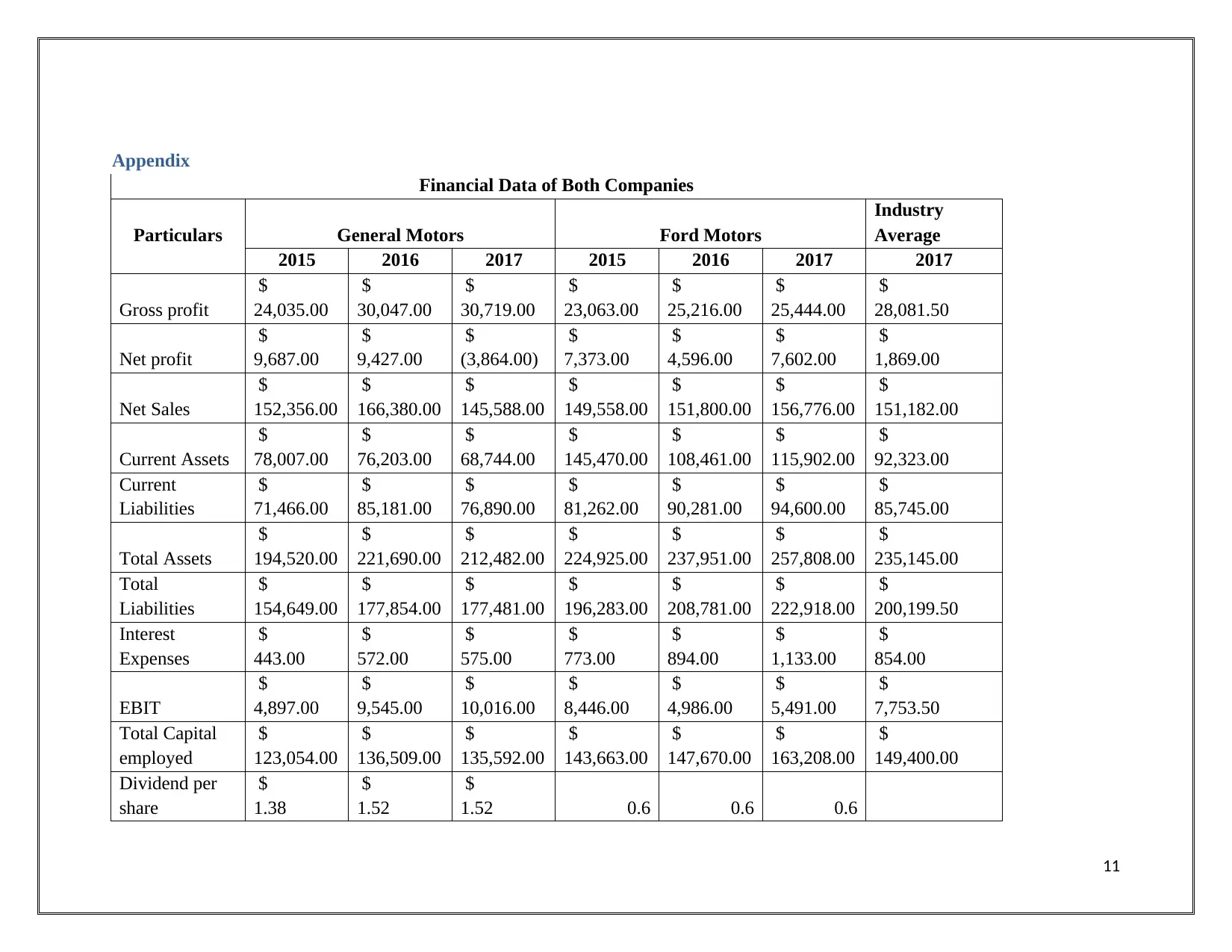
Appendix
Financial Data of Both Companies
Particulars General Motors Ford Motors
Industry
Average
2015 2016 2017 2015 2016 2017 2017
Gross profit
$
24,035.00
$
30,047.00
$
30,719.00
$
23,063.00
$
25,216.00
$
25,444.00
$
28,081.50
Net profit
$
9,687.00
$
9,427.00
$
(3,864.00)
$
7,373.00
$
4,596.00
$
7,602.00
$
1,869.00
Net Sales
$
152,356.00
$
166,380.00
$
145,588.00
$
149,558.00
$
151,800.00
$
156,776.00
$
151,182.00
Current Assets
$
78,007.00
$
76,203.00
$
68,744.00
$
145,470.00
$
108,461.00
$
115,902.00
$
92,323.00
Current
Liabilities
$
71,466.00
$
85,181.00
$
76,890.00
$
81,262.00
$
90,281.00
$
94,600.00
$
85,745.00
Total Assets
$
194,520.00
$
221,690.00
$
212,482.00
$
224,925.00
$
237,951.00
$
257,808.00
$
235,145.00
Total
Liabilities
$
154,649.00
$
177,854.00
$
177,481.00
$
196,283.00
$
208,781.00
$
222,918.00
$
200,199.50
Interest
Expenses
$
443.00
$
572.00
$
575.00
$
773.00
$
894.00
$
1,133.00
$
854.00
EBIT
$
4,897.00
$
9,545.00
$
10,016.00
$
8,446.00
$
4,986.00
$
5,491.00
$
7,753.50
Total Capital
employed
$
123,054.00
$
136,509.00
$
135,592.00
$
143,663.00
$
147,670.00
$
163,208.00
$
149,400.00
Dividend per
share
$
1.38
$
1.52
$
1.52 0.6 0.6 0.6
11
Financial Data of Both Companies
Particulars General Motors Ford Motors
Industry
Average
2015 2016 2017 2015 2016 2017 2017
Gross profit
$
24,035.00
$
30,047.00
$
30,719.00
$
23,063.00
$
25,216.00
$
25,444.00
$
28,081.50
Net profit
$
9,687.00
$
9,427.00
$
(3,864.00)
$
7,373.00
$
4,596.00
$
7,602.00
$
1,869.00
Net Sales
$
152,356.00
$
166,380.00
$
145,588.00
$
149,558.00
$
151,800.00
$
156,776.00
$
151,182.00
Current Assets
$
78,007.00
$
76,203.00
$
68,744.00
$
145,470.00
$
108,461.00
$
115,902.00
$
92,323.00
Current
Liabilities
$
71,466.00
$
85,181.00
$
76,890.00
$
81,262.00
$
90,281.00
$
94,600.00
$
85,745.00
Total Assets
$
194,520.00
$
221,690.00
$
212,482.00
$
224,925.00
$
237,951.00
$
257,808.00
$
235,145.00
Total
Liabilities
$
154,649.00
$
177,854.00
$
177,481.00
$
196,283.00
$
208,781.00
$
222,918.00
$
200,199.50
Interest
Expenses
$
443.00
$
572.00
$
575.00
$
773.00
$
894.00
$
1,133.00
$
854.00
EBIT
$
4,897.00
$
9,545.00
$
10,016.00
$
8,446.00
$
4,986.00
$
5,491.00
$
7,753.50
Total Capital
employed
$
123,054.00
$
136,509.00
$
135,592.00
$
143,663.00
$
147,670.00
$
163,208.00
$
149,400.00
Dividend per
share
$
1.38
$
1.52
$
1.52 0.6 0.6 0.6
11
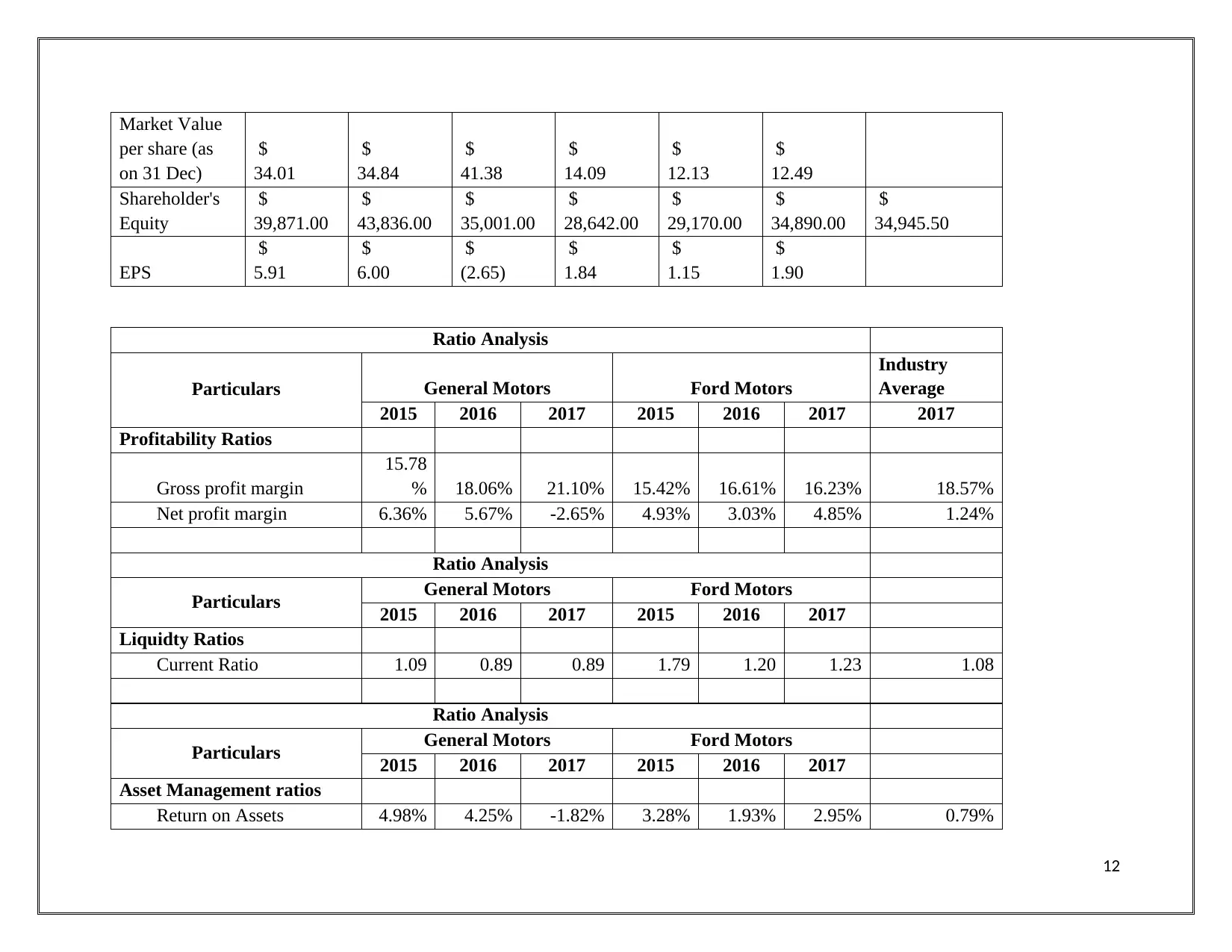
Market Value
per share (as
on 31 Dec)
$
34.01
$
34.84
$
41.38
$
14.09
$
12.13
$
12.49
Shareholder's
Equity
$
39,871.00
$
43,836.00
$
35,001.00
$
28,642.00
$
29,170.00
$
34,890.00
$
34,945.50
EPS
$
5.91
$
6.00
$
(2.65)
$
1.84
$
1.15
$
1.90
Ratio Analysis
Particulars General Motors Ford Motors
Industry
Average
2015 2016 2017 2015 2016 2017 2017
Profitability Ratios
Gross profit margin
15.78
% 18.06% 21.10% 15.42% 16.61% 16.23% 18.57%
Net profit margin 6.36% 5.67% -2.65% 4.93% 3.03% 4.85% 1.24%
Ratio Analysis
Particulars General Motors Ford Motors
2015 2016 2017 2015 2016 2017
Liquidty Ratios
Current Ratio 1.09 0.89 0.89 1.79 1.20 1.23 1.08
Ratio Analysis
Particulars General Motors Ford Motors
2015 2016 2017 2015 2016 2017
Asset Management ratios
Return on Assets 4.98% 4.25% -1.82% 3.28% 1.93% 2.95% 0.79%
12
per share (as
on 31 Dec)
$
34.01
$
34.84
$
41.38
$
14.09
$
12.13
$
12.49
Shareholder's
Equity
$
39,871.00
$
43,836.00
$
35,001.00
$
28,642.00
$
29,170.00
$
34,890.00
$
34,945.50
EPS
$
5.91
$
6.00
$
(2.65)
$
1.84
$
1.15
$
1.90
Ratio Analysis
Particulars General Motors Ford Motors
Industry
Average
2015 2016 2017 2015 2016 2017 2017
Profitability Ratios
Gross profit margin
15.78
% 18.06% 21.10% 15.42% 16.61% 16.23% 18.57%
Net profit margin 6.36% 5.67% -2.65% 4.93% 3.03% 4.85% 1.24%
Ratio Analysis
Particulars General Motors Ford Motors
2015 2016 2017 2015 2016 2017
Liquidty Ratios
Current Ratio 1.09 0.89 0.89 1.79 1.20 1.23 1.08
Ratio Analysis
Particulars General Motors Ford Motors
2015 2016 2017 2015 2016 2017
Asset Management ratios
Return on Assets 4.98% 4.25% -1.82% 3.28% 1.93% 2.95% 0.79%
12
⊘ This is a preview!⊘
Do you want full access?
Subscribe today to unlock all pages.

Trusted by 1+ million students worldwide
1 out of 13
Related Documents
Your All-in-One AI-Powered Toolkit for Academic Success.
+13062052269
info@desklib.com
Available 24*7 on WhatsApp / Email
![[object Object]](/_next/static/media/star-bottom.7253800d.svg)
Unlock your academic potential
Copyright © 2020–2026 A2Z Services. All Rights Reserved. Developed and managed by ZUCOL.




